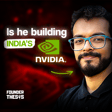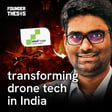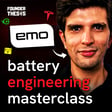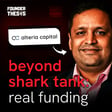Become a Creator today!Start creating today - Share your story with the world!
Start for free
00:00:00
00:00:01

Democratizing Satellite Technology | Sanjay Nekkanti and Chaitanya Dora Surapureddy @ Dhruva Space
Dhruva Space is in the business of making space accessible to businesses. Sanjay and Chaitanya talk about low earth orbit satellites, why satellites are a big business, and how they are building the full stack for enterprises to take advantage of satellite technology.
Additional links:-
Transcript
Introduction of Co-founders
00:00:00
Speaker
Hi guys, this is Sanjay, CEO and co-founder of Druva Space. Hey guys, this is Chaitanya, CFO and co-founder of Druva Space.
Space Tech in India - A New Frontier
00:00:20
Speaker
Space – The Final Frontier You might remember these iconic lines from the Star Trek series and movies. As anyone who is closely following the space tech sector in India would know, space is now closer than ever. In this episode, your host Akshay
00:00:35
Speaker
Jayadat is talking with Sanjay Nikanti and Chaitanya Dora Surapur Reddy, the co-founders of Dhruva Space, which is in the business of making space accessible to businesses. Sanjay is literally a rocket scientist who became a founder and Chaitanya is the data scientist who joined hands with Sanjay.
00:00:53
Speaker
In this conversation, they talk about all things space, including low-Earth orbit satellites, why satellites are a big business and how they are building the full stack for businesses to take advantage of satellite technology. Stay tuned and follow the Founder Thesis podcast and any audio streaming app to learn about conquering new horizons and making dreams come true.
Inspiration and Early Journey in Space Exploration
00:01:19
Speaker
My dad used to work for the military engineering services. So after my birth, I was based in Hyderabad. So I did all my schooling here and my seventh standard was a little unusual. I was in the city called Butch and Butch is an Air Force station. So every day after school, there used to be a point where I used to go and see the fighter jets take off.
00:01:43
Speaker
I was actually preparing for IIT-JE. I didn't get into any of the IITs, so I had a couple of options. One was Maripal, VIP, and SRM. I picked SRM. So I picked the stream of electronics and telecommunication. And I used to have this unusual hobby called ham radio, wherein you have a license that is issued by the government of India, and you could use it to talk to different people around the world.
00:02:12
Speaker
In a ham radio, essentially what you have is a radio set. And this radio set can communicate in different frequencies. So you have different frequency bands, especially for long distance communications. You use this band called HF, which is the high frequency. And in HF, you know, you can talk to people as far as even Russia.
00:02:36
Speaker
So I was this ham radio operator in college and one fine day there was a scientist from ISRO who had reached out to our university and said we as students could actually build and launch our own satellite. You know our college management was they were like very excited they felt that if this is really possible then they really want their students to build and launch the satellite.
00:03:02
Speaker
I thought that this would probably not kick off but a couple of months down the line actually our college decided to fund a student satellite project and the student satellite project comprised of students from different engineering departments coming together to build a satellite. People from computer science would write the code, people from mechanical engineering department would build the structure
00:03:28
Speaker
The Tripoli department would do the power systems for the satellite, so on and so forth. And the telecommunications department is responsible for the communications with the satellite. So our department was like, hey, we have this guy who's a ham radio operator.
00:03:46
Speaker
who's been here and done similar work in the past. So they suggested my name to be part of that group. And that's how I got into the space of actually building satellites. So as part of the team, I was handling the communication system and the ground station part, which is operations of the satellite. And we were a team of about 30 to 40 students who were given the responsibility to build a satellite.
00:04:13
Speaker
Launching responsibility was in the hands of ISRO because we were not building the rocket. And it so happened that we were challenged. So ISRO said, look guys, you have to build and launch your satellite in less than 24 months of signing the MOU. And if you do not complete it within the stipulated time, then, you know, we are sorry, you're not going to fly.
00:04:35
Speaker
So we named our first satellite SRM SAT because it was the university SRM university who was funding the project. And it was SRM SAT mission, India's first student nano-satellite. Within a period of about 24 months, we had to develop the full satellite. And while building this, we also had to do our coursework.
00:04:55
Speaker
The first step to getting something done as soon as possible would be to buy different parts and then put them all together. And we did that exercise. So when we did that exercise of finding different parts to put it all together, the cost was very, very high. So we were talking in terms of tens of crores.
00:05:14
Speaker
Now the budget that was allocated was just a few crores. So in order to achieve all of this in such a short period of time, it was quite challenging for us because now we had to develop everything ourselves to keep the
Overcoming Challenges in Student Satellite Projects
00:05:29
Speaker
costs low. But what was very exciting is that now the challenge is even bigger. You have to do it all yourself, build it all yourself.
00:05:38
Speaker
But the best part was we were getting guidance from the stalwarts of the Indian Space Research Organisation. I still remember this one particular incident. We needed to test our satellite and for testing you need to put it on a vibration bench which can be very expensive.
00:05:56
Speaker
And there were also several other tests that we had to perform and they were all like very expensive to procure. So we went to our director of research back then and told him, Sir, do you expect us to build this? But how can we do it? We don't have the resources. And this person is a former ISRO scientist. So he goes on to say, guys, have you seen that picture of ISRO carrying the satellite on a bullock car?
00:06:23
Speaker
Yeah, I do recall, I have. You just have to find innovative means to actually solve your problem. And when you look at a problem and you think to solve that problem the way how everybody else has solved it, that's one approach. But you could always take a very different approach to solving problems.
00:06:46
Speaker
So within a short period of about 24 months, we actually ended up building almost all the subsistence of the satellite. And we had also realized it within the shoestring budget. And while doing all of this, one thought that was running in my mind was we're a country with a billion people, but there's not a single private company in the country that is building these solutions for the global market.
00:07:09
Speaker
Because when we wanted to build a satellite and we went out into the market to find the cost of different systems, putting all together, it was running into tens of crores. But now when we built it all ourselves, it was within a small budget.
00:07:24
Speaker
and Indian space program is well known for that frugal innovation. And that
Founding Druva Space and Global Vision
00:07:30
Speaker
was really the motivation for me towards thinking about starting company to provide space technology solutions for the global market from India.
00:07:40
Speaker
I immediately went and pitched this idea to my fellow team members in the project. And I said, Hey guys, it looks like a great opportunity. We should do it. But everybody in the satellite team had job offer already in place. And the startup India movement and the trust from the government to support entrepreneurship really came up in this decade. But in the last decade, in the era of 2000 to 2010, it was not really that famous.
00:08:10
Speaker
So nobody was actually willing to take that risk of taking an entrepreneurial path. That too in a domain which is not very famous or not very common. But I still did push people saying they should do it. And one of them said, what is the guarantee that if you do this, somebody is really going to buy it. And if you're talking about building in India and selling globally, you really need validation that if you build in India, somebody in the Western world is really going to buy it.
00:08:37
Speaker
So what we had done back then was I thought it was fair enough and we really had to validate to some sort of validation. So what we did was we picked one of the sensors that we had used in the satellite. The same sensor also has some applications on ground and we had actually produced them in a small quantity and put it up on eBay for people to buy and use them. And it actually worked. There were a few people who actually bought some of these sensors.
00:09:06
Speaker
So at least for me, the validation was there that if you have an idea, if you have a product, and if you're really trying to solve a problem, then there's a strong business case that can be explored. My backup option was that I would go and do my masters in the same field. We built satellites in India. I wanted to see how satellites were built in the Western world. So I got accepted to this program called Erasmus Mundus Space Master.
00:09:31
Speaker
My class size was about 44 people coming in from 27 different countries. We learned different domains of space technology in different countries. So I spent about six months in Germany where we worked on small satellites. And it was very interesting because in India I built a nano-satellite which was a 10 kg class satellite.
00:09:54
Speaker
Nano satellite would be the size of a desktop printer. And in Germany, we were working on satellites that are the size of Tiffinbox. So you're saying that nano is bigger than small satellites? Yeah, nano is bigger than satellites that I learned working on it. Pico satellite, okay.
00:10:13
Speaker
So satellites don't have propulsion in it, do they? Few satellites do have. So satellite is essentially a collection of telecommunication instruments and sensors. It is sensing some data and then it is communicating the data back to Earth. It has many things. It has the satellite structure. It has your satellite solar panels, which generate power for the satellite. It has a power distribution unit and a storage unit.
00:10:41
Speaker
which charges the battery, supplies it to different parts. Then like a computer, there is also an onboard computer for a satellite whose job is to do things intelligently in terms of commanding, controlling, et cetera.
00:10:56
Speaker
Then you have a system called attitude determination and control system, which essentially determines the orientation of the satellite in space. And that is a combination of several sensors and actuators. And propulsion is one part of it. Like you use sensors like sun sensors, earth sensors,
00:11:20
Speaker
star sensors, you use global positioning systems, and you run different orbital algorithms. It's a fairly complex system. And you use these torquer coils and action wheels, et cetera, as different actuators to stabilize the satellite. After all of this comes your communication system whose job is to send health data of the satellite.
00:11:47
Speaker
receive signals from the ground and give that information to the OBC, et cetera. And then you have the payload. Payload is essentially what is the main task of the satellite. So if you're a weather satellite, then the instrument becomes part of the payload. If it's imaging satellite, then camera is the payload, so on and so forth. And space systems engineering entails putting all of these together.
00:12:13
Speaker
What is a torque coil? Torque coil is like a coil bounded around a metal bar that is needed for producing electric and magnetic fields to ensure that it generates a certain torque in a particular direction to stabilize the satellite.
00:12:31
Speaker
And this German university had already built and launched about three satellites by then. And after that, I spent the next one year in Sweden at the Swedish Institute of Space Physics. It's in a place called Kiruna and it's inside the Arctic Circle. And Swedish Institute of Space Physics is really well known for building instruments that go on to a lot of interplanetary missions.
00:12:59
Speaker
So it was really exciting to mix with different cultures, learn different parts of the space tech value chain, work on different types of missions like satellites in Germany, instruments in Sweden. I think I also had the opportunity to work on instrument and send it up the stratosphere about 35 kilometers using a high altitude balloon. And then for my master thesis, I had two options.
00:13:29
Speaker
The first one was doing a project at NASA Ames Research Center on a mission to Titan. So just randomly one day I just wrote to a professor at NASA Ames and said I'm really passionate about this particular subject and this is my past experience and I would
00:13:47
Speaker
really like to get into doing some project under your guidance. And this professor, he had actually worked on missions from ours. And within 12 hours, I actually got a response saying, your profile looks interesting. And there is a space systems engineering project that you could potentially work on. And we had multiple calls over the next few days. And it was a clear fit for me to go and work on a mission there.
00:14:15
Speaker
But yeah, one of the biggest challenges was to get my visa within a precipitated time to go there and do it, which I couldn't get. So my backup option, if NASA didn't work out, was to go to Singapore, work on the first few satellites that were being built at Singapore. So I worked as a research assistant at Nanyang Technological University. And I played an important role in assessment and qualification of the first few satellites built there. How did this lead
00:14:45
Speaker
Yeah, as part of my master's program, I was still having that thing in mind that I should go back to India after my master's and start a company, start a space tech company. So I spoke to my peer group and said, hey, you know, we should do this. There's a big market, try to convince them. And I was able to convince one of them to come back to India along with me to start Druva space.
00:15:08
Speaker
So yeah, finished my Masters in 2012, came back to India and started Druva Space. So the founding team, initial founding team of Druva Space is very different from the current founding team of Druva Space. And that's what we will learn from very shortly.
00:15:26
Speaker
So when we started the company in 2012, we were mostly focused on supporting student satellite projects that were happening in the country. And I would say we were also closely working with the Indian Institute of Astrophysics with Professor Jayant Murthy. His team was working on high altitude ballooning missions. So we supported some of these missions in the first phase between 2012 and 2015.
00:15:51
Speaker
It was very difficult for us to find customers within the country and also outside of the country because in the space sector, it was extremely important that there was already some heritage in the sense we should have already built and launched something so on and so forth.
00:16:06
Speaker
And access to venture capital was also very tough. When you speak to investors, it's also the same thing. Have you done this? If so, has ISRO validated it? Have you launched it into space? Do you have paid customers with you? How can we be so sure that this model is going to work so on and so forth?
00:16:26
Speaker
So really in the first part of the Dhruva journey between 2012 and 2015, it was an exploratory phase and it was very, very tough. But we got a very good hang of what customers want, what investors want, what partners want, and how do you build a great team.
Pause in Operations and Consulting Shift
00:16:44
Speaker
So we paused our operations in 2015 and I started consulting. In 2015, you were running as a technology consulting partner, basically. That's what you would have been doing.
00:16:55
Speaker
Or were you trying to do a product, like actually build a satellite as a product? So I would say it was a mix. Largely it was consulting, but we also conceptualized a satellite program for and sat in there, but work through the details of it. We had the designs ready, blueprints ready.
00:17:14
Speaker
But we couldn't really do much because for us to do that, we needed access to capital. So around 2015, we took a step back. We paused the operations. My co-founding team back then also started consulting and they also moved out of the country.
00:17:30
Speaker
Narayan Prasad, who is the founder of Sac Search, today was also the first co-founder of Druva Space. Mr. Abhishek Raju, who is the co-founder of Sharp, was also a co-founding partner at Druva Space. And so what I did was I continued to stay in the country. Narayan moved to Germany and Netherlands. After that, moved to Switzerland.
00:17:54
Speaker
I stayed back in India. I was consulting for various companies. I was consulting for Antenna Manufacturing Company. I was consulting for Typol, where I found my current co-founding team. And I was also consulting for a company called Exeatspace, which is now called Satellice.
00:18:13
Speaker
But yeah, the real mix of great team of engineers, great team of founders came through Tybolt. And today that is the real foundation block of Druva 2.0. And so Tybolt is where Chaitanya's story comes in. Yes.
Chaitanya's Path and Creation of Tybolt
00:18:32
Speaker
Okay. So Chaitanya, tell me about your journey of starting up Tybolt.
00:18:36
Speaker
If you don't mind for that, I need to get a mental image out of my head. So when Sanjay was telling us the bullock card story, he's saying that he said this thing. So now my doubt is instead of vibration table, did you put the satellite on a bullock card and run it through a very rocky road for the vibration bench test? Yes. But anyway, coming back to the question at Handia, we studied together at 11th and 12th, me, Sanjay and Abhay. Then was that I, Abhay and Krishna, the other two co-founders, we studied together in Bitzpilani Goa campus.
00:19:04
Speaker
I decided early on that I want to move more onto the business side of things. So post-graduation, I did my master's in management from EM Lyon in France, came back, worked with KPMG and management consulting, where I was advising the government of AP, and then went on to work with an NGO called Safe Water Network, where I was leading their IoT team. And I wrote a year into working there and Ryan Trishna started up Tybalt. So they're like, do you want to come join?
00:19:32
Speaker
Helier, working with a couple of your friends. And of course, I always wanted to be an entrepreneur, leading the business side of things. I jumped in missing IDI. And that's when Tybalt started. So we started off in 2017 as a company. And we initially wanted to work more as a design house.
00:19:47
Speaker
So not really an out-and-out startup because we realized that the IoT products that we've chosen to build, getting the market access to these is pretty tricky. So we were trying to work with established companies who are already in that field. We build the design, we have the IP, we work with them to take the product to the market, and we take royalties out of the whole deal.
00:20:07
Speaker
So that's where it started off and Sanjay was having already had an out-and-out career in entrepreneurship. He was advising us. We developed a couple of interesting products. One, ultrasonic motor meter, the first one to be officially approved by FCRI in the country with an IoT angle to it and also water quality sensors for shim farming and a complete suit that we built around that area.
00:20:29
Speaker
While we were doing this, Sanjay comes up to us and he was like, guys, I think it's time to revive Dhruva space. Why don't you join me in doing that? And he's like, you guys, we'll make the perfect fit. You have so-and-so competency. I have so-and-so competency. It's real, you can take off. And there was also a good traction from the investors around this period where the space was kicking off. My take to that was, dude, I have no clue what space is.
00:20:51
Speaker
I'm fascinated by space. I dreamed of space as a kid. It's brilliant, but me, I haven't done engineering in a while, science in a while. And now this is, it's rocket science or satellite science in our case. He's like, okay, why don't you do this small exercise? There was a call by European space agencies, business incubation centers.
00:21:08
Speaker
Where for incubation, they said, you guys can come into bed. There was a proposal that we need to write. Like, why don't you just write it by yourself? Like, sure. So I wrote with a little bit of help from Abhay. And Sanjay is like, I'm completely staying off of it. You don't do it yourself. So then you get that compliment.
00:21:24
Speaker
So I got some help from Abhay and Krishna, wrote most of it by myself. Then we were invited to come pitch in Austria. So we are like, okay, still in the initial stages of our entrepreneurship journey, didn't want the whole team to travel. So I sent Abhay. He went, which trip, usually it was a two-day trip. I was like, I felt it made sense to stay for a bit, travel around, but he's like, no, I'm coming back. Which was back exactly two days later. And they invite us and say, please come and give it. I was like, okay,
00:21:50
Speaker
That gave me the confidence and I think I'm like, okay, fine. I think yes, we can bring in a lot of capability, even if I have not built a satellite or worked in this thing. So that capability that Sanjay has, again, working with friends was the most exciting part for me. Essentially Highbolt was like just the co-founders. Like it was not like a company which had a lot of employees and all of that. So hence the co-founders moved into Dura space. Like that's how that like you joined forces or
00:22:17
Speaker
We had a team of around 12 to 14 in Tybalt itself, but we did carry on the whole team because even the team was built, especially on the engineering side and the product development, they were letting this thing train. And Tybalt was in the space of IoT, like that was the IoT and IoT based analytics, like that was the core area.
00:22:35
Speaker
Yeah, exactly. It was IoT and mostly on the hardware side, a bit on the software side. So when did you decide to join hands and collectively become Dhruva? I'd say early 2019, we decided to join hands and go and restart Dhruva.
Future Goals: From Product to Service in Satellites
00:22:51
Speaker
Let me ask Sanjay here now. So when you restarted Dhruva with the Thai board team, what was the thesis? What did you want to do?
00:22:59
Speaker
It was very clear that we wanted to be a product company, but we also have had the sense that services is something that we might do in the future. And that's been a path also at Tybolt that we were conceptualizing. So we are a product company that can in future do services leveraging the product.
00:23:24
Speaker
And what is the product that Dhruva was pitching? Like you went to Mumbai Angels to pitch for funds. What did you pitch there? What was the product? Yeah. So what we did was we actually broke down what was the biggest challenge in the space industry. So this is what we looked at. Constellations of satellites was becoming a very common term. And when you say constellations of satellites, you're talking about launching hundreds of satellites in one go.
00:23:52
Speaker
This is what Bharti is doing for satellite internet or Elon Musk is also doing Starlink for basically satellite internet. This satellite internet coverage, you need a constellation of satellites to ensure 24 hour coverage. So that is the concept. Yes, that's correct. So everybody was talking about constellations, right? Guys who are building constellations, what is driving that business?
00:24:17
Speaker
their business driver is not the space asset. The business driver is the data coming out of the space asset. Yeah. The party hotel is selling like a MBPS per MBPS. That's what their revenue would be. Like how many MBPS or like, what is the GB of data consumed? Yeah, that's correct.
00:24:36
Speaker
And then other companies that are building weather satellites, somebody is doing imaging satellites, et cetera. And now if you look at the landscape, US government has roughly about 1,500 space assets. China has roughly about 500 space assets. India has lost about 80 of its own satellites in the last four to five decades. So this number is the government or overall US government private both 1,500 space assets.
00:25:05
Speaker
only government. OneWeb has filed for launching more than 5,000 satellites. Starlink has filed for launching more than tens of thousands of satellites. So now if you can understand the scale, you're talking about launching tens of thousands of satellites.
00:25:22
Speaker
like there are at least 100 countries in the world today that have never launched anything to space and countries which are also known as spacefaring nations the number of satellites have been smaller so where I'm getting at is the problem that we are really trying to solve
00:25:39
Speaker
is to break that barrier. There needs to be a fundamental change in how you build satellites, how you launch them, and how you operate them. And that's the problem that Druva has picked and is building. So we are building platforms that enable organizations to launch their own constellations.
00:26:02
Speaker
So essentially, it's like a plug-and-play approach to launching a satellite. You don't need to, like what took you 24 months at SRM to launch that one satellite. Today, somebody could just log on to the Drova platform and in the pretty short time, they could have a satellite scheduled for launch. That's the vision. Yes, that's the vision.
00:26:23
Speaker
Got it. Okay. So we broke it down into simpler parts. The integral part of any space mission are three pillars. The first one is your space pillar, which is building off the satellite itself. The second is the launch pillar, which is launching and putting the satellite in the orbit.
00:26:41
Speaker
The third is the operations or the ground pillar, which is used for commanding and controlling the satellite. So we are a product company where we build products in all these segments to enable the full constellation. So on the space segment or on the space pillar, we build satellites that are application agnostic.
00:27:04
Speaker
So for example, somebody might want to do a satellite for only communication, then we have a different platform. Somebody wants to do imaging, then they use a different platform. Somebody wants to do very sophisticated missions and for that we have a different one.
00:27:20
Speaker
what we don't do on the satellite is we don't build the payloads. So payloads are like, because there is a lot of diversity in payloads, every company will have their own design for a payload. So that they will like just plug into the satellite, but the everything else except for the payload, you are like a plug and play service. Correct, correct.
00:27:40
Speaker
This is what we do on the space segment on the launch segment. See, we would want to launch satellites at a faster pace, right? Now, if we, we could look at the possibilities of building our own launch vehicle, but instead what we thought is that's a very, very difficult problem to solve. And we, and none of us have that experience in that domain. So we picked the interface problem.
00:28:05
Speaker
Our satellites should have the possibility to go on to any rocket. So we started building the interfaces that would enable our satellites to go on to any rocket. So we built those deployers. Then you build it, you launch the satellite. Now you need the operations piece to operate the satellite. So we have a product that you can use to operate satellites, existing as well as the ones that will come up in the future.
00:28:32
Speaker
So how do rockets deploy satellites? I thought that it would be like a cavity in a rocket where all those satellite boxes are placed and it just ejects those. It's not like that, is it? Yes, it does. But those cavities are not those boxes are made by very few people around the world and they can be very, very expensive.
00:28:54
Speaker
So we build those boxes and cavities that can go on to any rocket. So tell me the evolution. So you had this ambitious plan to become a platform offering all three pillars, space, launch, and ground
Satellite Mission Steps Explained
00:29:07
Speaker
ops. Tell me the evolution, how you started.
00:29:10
Speaker
So we went the same way how we would go ahead and build our first satellite. So before you launch a satellite, you apply for your frequency. You first set up your ground station. Then you would go and also figure out the launch side of things. Like when tentatively you're launching the satellite and pay in advance and book that launch slot. And then get to the space segment wherein you actually start building the satellite.
00:29:37
Speaker
So one of our strategies was that we need to have a paying customer before we build a product. And that was extremely important for us. Oftentimes we as engineers fall into that trap of building a very rosy product, but which people may not actually need.
00:29:56
Speaker
So what we started off was we started talking to prospective customers who were interested in having their own space program. And we had already architected the bare bones of the product.
00:30:11
Speaker
And we went ahead and pitched it to a few people. And one of the forward-looking educational institutions, based in both Andhra Pradesh and Telendana, they were very excited and they moved forward. And this is Bibi Raju Institute of Technology. It's like an engineering college. Yes, an engineering college.
00:30:31
Speaker
So they wanted their students to build and launch a satellite and they wanted a long-term roadmap that they didn't want something one-off. They wanted a five-year roadmap, a seven-year, ten-year roadmap on how the program could evolve and how that would have an impact on the students on a career path and also in terms of in general, working on high-tech products and projects.
00:30:56
Speaker
So with that thesis, we had required our first customer, which is for building the ground segment. Now on the launch segment, there was an announcement of opportunity from ISRO where they said there was a global call and they asked organizations to submit proposals that would be, and they would pick
00:31:19
Speaker
proposals for a free launch that are of national importance or are of societal benefit. And we believe that there was a clear gap for production of these deployers in India. So we had submitted a proposal for them to accept our strategy on building these deployers and testing them in orbit.
00:31:42
Speaker
So a deployer is a box that goes inside the rocket and the satellites are loaded inside that deployer and it throws them out or something like that. Correct. And our proposal got accepted. So we have the ground segment, we have the launch segment. Now comes the space segment.
00:32:02
Speaker
On the space segment, we were already architecting a platform. All the blueprints were ready. We had certain ideas on what the platform should be doing, so on and so forth. And now that we had two pieces already solved, we're looking for a third piece so that we could offer a full stack solution.
00:32:22
Speaker
So we started talking to multiple customers and we actually ended up finding the customer to whom we could do a full stack, which has enabled them to build a satellite. We will be launching the satellite for them and establishing a ground station. And we went one step further where we also found repeatability of customers. Which customer was this that you signed up? It's an academic institution in Odisha.
00:32:47
Speaker
So again, the goal is education, like it would have an engineering course and the engineering students would learn to build satellites and work on the data from them and stuff like that. Actually, no. So as part of the ecosystem building exercise, we wanted our programs to have a very strong industry, academy or collaboration.
00:33:10
Speaker
So most of these are doing about three programs now and with the Academy and all these three programs are faculty led programs. So it's not like a student satellite project, but it's a faculty satellite project. Got it. So it allows that college to go out and get work from corporates. Essentially, they as knowledge partners for corporates can run some of these things.
00:33:38
Speaker
Yes, absolutely. So think of it this way. So today we are training the faculty in building and launching the satellite. Tomorrow, we would be in a position to actually give the faculty an R&D project to build and develop it and give it back to us. Okay.
00:33:53
Speaker
Okay. Got it. So this is one market vertical. Then the other market vertical that we have is government and defense. And the third vertical that we have is enterprise customers. So on the government vertical also, we have a customer. This is a defense client for whom we are building space-grade solar panels for their satellite project. And on the enterprise side, we're having conversations with overseas customers to meet some of their requirements.
00:34:22
Speaker
And are these funded by customers or did you raise funds to fund these projects? So all in all, we are executing orders worth three and a half million dollars. And for all these projects, although the customer had given us a small advance, we had to raise capital to execute these orders. Okay. And tell me about that fundraise journey. Did that pitch to Mumbai Angels? Did it work out? Did it convert?
00:34:48
Speaker
Yeah, so when we raised our first round of capital, we had met about 160 investors in the country. And I'm really thankful to the Mumbai Angels team and actually enabling us quite a bit. See, most of the investors that we met felt that we were raising too less capital with a very broad goal and it wouldn't be sufficient for us.
00:35:11
Speaker
But out of the 160, I would say a small portion of them came on board to support our journey. So we raised about four and a half crores through Mumbai Angels and Lead Angels. This was our first round in November of 2019. After that, we raised our next round last year of about three million dollars from the Indian Angel Network Fund and Blue Ashwa Capital.
00:35:38
Speaker
So when you say you have three million dollars worth of orders to execute, so how do you charge? Is it that say somebody like your first client was an engineering college that wanted a ground operations center to be built? So is it a subscription or is it a one time fees or what is the economics of it?
00:35:56
Speaker
As I mentioned, we are a product company. So we have a product pricing. Customers pay for the product. Some of these have a lead time for delivery. Usually we have customers also pay in advance before the full delivery of the product. Give me an idea. How much would it cost to set up a ground operations center or how much would it cost to launch a satellite?
00:36:18
Speaker
Yeah, we offer training to organizations to build, launch, and operate their satellite starting at about 2 crores. And this doesn't include hardware, like the actual satellite? This includes hardware. Okay, it includes hardware. Okay, okay, okay. In starting at 2 crores, the organization could have a satellite in space which is sending the data back and they are able to work on that data. Correct.
00:36:44
Speaker
But this would be only a communication satellite. If you're looking, imaging satellites, et cetera, the price can go up to two to $3 million depending on what size of satellite, which orbit you want to launch your satellite, how many ground stations you need, so on and so forth.
00:37:03
Speaker
Help me understand some of these decisions. Which orbit does a satellite go into? What is the criteria for that decision? And whether you need one ground station or both in one ground station, what is the criteria for that decision? Okay. So most of the satellites that we build at Dhruva are all going into the lower orbit. And typically a satellite in lower orbit will go around the earth 14 times in a day. You know, it's capturing a lot of data.
00:37:28
Speaker
right now if you want to bring down all of this data then you know you will have to have ground stations distributed around the world but if you are interested in data only let's say over India then you know maybe a few ground stations in India or one ground station in India would suffice this is with respect to the ground segment now with respect to the orbit
00:37:54
Speaker
See, the orbit will come into question largely when you want to launch more than a few satellites in one go. Okay. Because think of it this way. If you launch more of them, you will have the flexibility to get coverage over a region of interest with less number of satellites or more frequent visits, so on and so forth.
00:38:16
Speaker
Typically satellites are launched on low Earth orbit only, like that's the ideal orbit or what determines that whether it's a low Earth orbit or what is the opposite of, is it a high Earth orbit or what do you. Yeah. So when I say orbit selection, I'm talking specifically in terms of inclinations. The small satellites are usually launched into the low Earth orbit, typically between 400 and 1200 kilometers. And what defines your orbit is also the primary satellite.
00:38:46
Speaker
because your small satellites typically weigh anywhere between one kilogram and 50 kilograms or less than 300 kilograms. If you're talking like launching on a launch vehicle like PSLV, PSLV carries up to 1800 kilograms. So now
00:39:03
Speaker
If you have to put only one satellite on a rocket that is carrying 800 kilograms, you cannot demand where you want to be put in orbit. So you will have to take what you get. But you said that these satellites have a propulsion system on board. So you are able to finalize what is the height at which, what is the altitude at which they should be, what path they should be taking through the propulsion system.
00:39:28
Speaker
Actually, it's a very good question. Not all satellites have propulsion systems Akshay. There are few satellites that specifically need propulsion system. There are few satellites that don't need propulsion system. And usually customers are okay to go to a location where the primary satellite is going because largely the primary satellite will also have a very decent coverage around the world.
00:39:54
Speaker
And what determines whether a satellite will have a propulsion system or not? As you pointed out, if they want to do some sort of maneuvers, moving an orbit up and down, then the propulsion system is needed. If you want to do orbit
00:40:10
Speaker
raising specifically, moving from one orbit to the other orbit, then the propulsion system is needed. Today, one of the upcoming areas where people are also using propulsion system is for deorbiting and to avoid collision risk, okay, which will be orbiting is after your satellite life is over.
00:40:34
Speaker
you will try to bring down the altitude of the spacecraft so that it can re-enter and re-enter the Earth's atmosphere and burn out during reality. And why would a satellite want to change its orbit? Like you said, you need propulsion if they want to raise the orbit. Why would a satellite want to do that?
00:40:51
Speaker
Okay, that depends on the application. Some missions, let's say you're doing formation flying, wherein three satellites have to come close to each other to study a particular area. In that case, without a propulsion system, doing a formation flying will be extremely difficult.
00:41:12
Speaker
This would be like for taking photographs or something like that. Comms also, let's say you want to triangulate and triangulate a signal on the ground. Then also you would need to do formation flying, etc. I want to talk a bit on use cases of satellite from a business perspective. And maybe you could throw some light that what are the business opportunities through satellites? Like first one is communications.
00:41:35
Speaker
Second one is Earth observation, which is you're studying your planet using imagery obtained from the satellites. It could have impact on how cities are designed, how much agriculture produces happening, et cetera.
00:41:52
Speaker
Third could be in navigation. So there's something called as PNT, positional navigation and timing. These are very important for your civil engineering construction applications, for your navigational applications. So if the future of vehicles is autonomous, satellites will play a very important aspect in autonomous navigation.
00:42:15
Speaker
In addition to this, you have space weather and you also have earth weather. Okay. And then you have general research and interplanetary missions. And then one of the other fields, which is really upcoming is farmer and biotech. Okay. But what is the use case for a farmer company to have a satellite?
00:42:40
Speaker
Okay. Usually if you have to get a drug out into the market, it takes anywhere between seven to 10 years or probably beyond that. So one of the very important aspects in this phase of drug development and drug discovery is
00:42:57
Speaker
crystal growths where different molecules are put together and crystals are grown and their characteristics are studied. Now, when you're doing this on Earth, you're actually trying to put it inside a small centrifuge that is trying to create some artificial gravity for those crystals to grow.
00:43:19
Speaker
The crystals grow faster in zero gravity. That's what you're saying. Yes. Yes. And they're very clear. So a lot of those can be used for drug discovery and drug discovery experiments. A lot of these are also being used for new cosmetics, formulations, so on and so forth. So there's an upcoming field.
00:43:42
Speaker
How would they be grown? Every time a pharma company wants to grow a crystal, they would launch a satellite with those raw ingredients in it, and the crystals would grow, and then there would be some onboard microscope which would allow them to study it, or would they then bring it back to Earth and then study it?
00:43:57
Speaker
Very good question. One of the capabilities of Druva is also that we can take things to space and bring them back to Earth. So we have a partner in the US. Through home, we could take payloads to the International Space Station, run an experiment there and also bring them back to Earth.
International Collaborations and Experiments
00:44:16
Speaker
We're also trying to walk with ISRO, where we could, in the future, also do something similar here in India. These use cases for which you feel that countries would launch satellites, a lot of these are off-the-shelf plug-and-play services, like communication, navigation, or even, I'm sure, for Earth observation. As a layperson, I know Google Earth does it, but I'm sure there would be more business, like, pro tools than just Google Earth for space observation.
00:44:45
Speaker
So why would countries want to launch satellites for all of this? A lot of data that we use today in our common life is data for which somebody is paying somewhere and it doesn't get noticed in a big way. And also your data may not be extremely accurate.
00:45:05
Speaker
So you must have if you've used an iPhone and put that thing on, on find my iPhone. And if you go and try to really find the exact location, especially in India, you will never be able to track where exactly is the phone.
00:45:22
Speaker
It will only give you an approximation. Just to add to that, the GPS boards that we get are built in with a certain offset wherein they are actively making your product showcasing little mistake in your final location. So this is because the form, the garment that has built your setup, they do not want you to use this, but highly accurate systems where you can probably abuse it. So they don't want to give that to your form garment.
00:45:47
Speaker
Similarly, you look at Ukraine. So during the war in Russia, one of the first things they did was destroy most of the comms, the internet, etc. So there was all this thing where they were taking help from Elon Musk on Starlink. So there are a lot of cases where you might not be able to rely on existing infrastructure, be it the foreign government,
00:46:08
Speaker
or a foreign company. Same thing comes with imaging. So you're at war, you're in a critical district, and you are dependent on a foreign company to give you the images. So there are quite a few of these things where it is necessary that you have your own. Okay, got it. Is there a way for governments to stop satellites from prying into sensitive areas? Can India just put up a satellite and look at China's nuclear facilities, for example?
00:46:35
Speaker
There are very interesting ways in which you could misguide the satellite also. For example, the satellites might detect a few colors. You know, you can have a camouflage on the ground that doesn't show off those colors.
00:46:52
Speaker
or when you look from space, objects look in a particular way. So you could actually have dummy objects trying to look like real objects. And of course, you could also jam signals if you don't want certain signals to come, etc. How would you jam a signal? Like you shoot a radio beam at that satellite to jam its outgoing signal, something like that.
00:47:14
Speaker
Yeah, jammer. So going into the technicalities of the jammer, you can produce higher power to saturate the other radio. It's not very different from how you jam signals on the ground. It's the same principles. My last question to you, what's the road ahead for Dhruva? Say by 2025, where do you see yourself?
00:47:34
Speaker
We've come a long way since we started the company in 2012. We're working very hard towards being a full-stack service provider for use cases in India, for customers in India and also outside of India. We believe today we have the potential to look towards owning our own constellation of satellites to offer specific services.
00:47:56
Speaker
I believe between 2025 and 2027, we might be heading towards having our own sets of satellites in orbit, trying to power solutions on the ground. Wow. Which would probably need a lot more fundraise also to launch a constellation. How much money would that need if you want to launch a constellation of satellites like $100 million or something?
00:48:18
Speaker
It really boils down to the application. It depends on what type of application you're targeting. See, using our P. series of satellites, we could create a network of satellites in the lower top bit to provide low data rate communications. And for us to put about 50 to 100 satellites, it would cost us anywhere between 10 to $20 million. What is a low data rate communication and low data rate as opposed to what? It's basically like bandwidth is low. Is that what it means?
00:48:47
Speaker
Yeah, this would be well suited for IoT applications, but may not be great for streaming 4k data. You can also probably use it for messaging in extreme remote areas, especially for emergency situation. So do you currently have customers outside of India or is your revenue largely from India?
00:49:07
Speaker
All our current book revenues are from India. We are closer to signing something with customers from outside of India. Do you have competitors in India or all your competitors are global? Are there other companies in India which are offering this full stack solution to launch satellites?
00:49:24
Speaker
I would say within India, we are largely complementary within the ecosystem. I've not come across a player who is a full stack provider from India yet, but yeah, we are largely complementary within the Indian ecosystem. And globally, there are players who are doing what you're doing. When it comes to competition from outside of India, there are definitely people who've raised more capital, who've already been there, done that, etc.
00:49:49
Speaker
Our thesis is very simple, Akshay. We are based in India. India has launched about 80 satellites so far. We believe these numbers are going to increase. We would like to be a very strong regional player. We want to be in the top three space companies in the country. And at the same time, provide our solutions in the global market. Our competitors have definitely raised a lot of capital and they are way ahead of us also because they come from very different markets.
00:50:18
Speaker
But I guess your strength would be frugal innovation, like probably the cost at which you would be able to do it would be much lower than what a global company would charge. So our key differentiator would be being faster, reliable and providing an economical solution for the global markets.
00:50:36
Speaker
So Sanjay, we recorded, and this is just a note for the audience that what you heard so far was recorded in the year of 2022.
Recent Achievements in Satellite Launches
00:50:45
Speaker
And Sanjay is joining us here for some updates. So Sanjay, please share with our listeners about some exciting updates that have happened.
00:50:54
Speaker
Yeah, I think I would say less than a year and we've gone to space twice in the process of going to space the third time. So I think the last one year has been like pretty crazy, pretty busy. And most importantly, you know, we've been doing a lot of things in space successfully.
00:51:12
Speaker
So what do you mean gone to space, just like paint a picture of that? Sure. So, you know, maybe just giving a quick refresher to the audience, you know, through our space is a full stack space technology company. We work on the space segment where we build satellites. We work on the launch segment where we don't necessarily build the rocket, but we build the interface between the spacecraft and the rocket, which enables our spacecraft to sit on any rocket in the world. And then, you know, the ground segment where we build
00:51:42
Speaker
these communication terminals for operating satellites once they're in orbit. In the last one year, we are happy to bring to your attention that we've completed the full loop. We've built the satellite, we've launched the satellites, we've operated the satellites. As of first February, two of our satellites, Tybalt 1 and Tybalt 2, have gone around the Earth more than a thousand times.
00:52:07
Speaker
Which is crazy. So this would have been like an Indian rocket company which launched it or like, where did you launch? Yeah. So let me actually break it down into pieces and you know, I'll just tell you about going to space. So our first launch happened in June of 2022. And in this particular launch, what we did was we tested our interface between the spacecraft and the rocket.
00:52:34
Speaker
So we didn't deploy anything into space, but that interface stuck on to the Indian Golar satellite launch vehicle. And once it went to space, we tested its performance, whether the door is opening properly, whether it is responding to the commands from the rocket properly, and so on and so forth.
00:52:54
Speaker
And in November, 2022, what we did was we used the same interface to actually deploy two satellites, one and Tybolt II, which are based on the P-dot platform, P-dot satellite platform of Druva space. And these missions are all authorized by the new regulatory body in India called InSpace.
00:53:21
Speaker
So until 2020, in India, the regulatory regime has been evolving. So in the year 2020, in space was formed. And in space is the regulatory body which will govern all the private space activities in the country. And technically, they were the ones who authorized us to do both of these missions.
00:53:46
Speaker
It's like a try for telecoms, a similar kind of a body for the space tech industry. Spot on. And what do these two satellites do? What's their commercial use? Okay, so these two are technology demonstration satellites, which do not have a commercial use case, but they are suited for the amateur radio applications.
00:54:09
Speaker
where ham radio operators from India could actually utilize these satellites to operate them for communication applications. What did we actually test? I would say the entire vDOT spacecraft platform of the rover space. So essentially, every part of the spacecraft
00:54:31
Speaker
meaning the satellite structure, the satellite solar panels, the communication modules along with an antenna deployment mechanism, the attitude determination control system of the spacecraft, all have been indigenously developed in Hyderabad. Essentially, most of it is
00:54:52
Speaker
not most of it. In fact, every part of the spacecraft has been designed, manufactured in India and sent to space for the first time. All of them have performed nominally, which I believe is a significant achievement because it's definitely rocket science.
00:55:13
Speaker
Yeah. What do you mean perform nominally? What does that term nominally mean? Performed as per the design. So all of the systems are performing exactly the way they are supposed to perform without any abnormalities. So this is your proof of concept up in the sky, basically. Absolutely.
00:55:34
Speaker
Right, right. And how has this helped you in terms of being able to win business? Are there some deals in the pipeline? Well, to be very honest, Akshay, you know, for the PDOT platform, we already have customers even before the 10 demo missions, but, you know, being a very customer centric company, it was extremely important for us that, you know, we wanted to give our customers the best experience.
00:55:59
Speaker
So we wanted to do this trial mission before the customer demos. So the customer demonstrations will happen this year. In terms of how has been the market reaction to what we've done, the market reaction has been extremely positive.
00:56:17
Speaker
And I truly believe that this small milestone of our company is having a significant impact, not just for our company, but for the whole country. A lot of foreign players who have leveraged the Indian rocket for
00:56:36
Speaker
launching their satellites are now looking to the Indian industries on how they can support their global ambitions. So I would say it's a small step, but a great milestone for the entire private space tech ecosystem in India.
00:56:54
Speaker
What are the kind of customers and for what kind of use cases are you focusing on? Because obviously the market is pretty huge, but you would probably want to have some specialization initially to go after a certain type of customer who wants to launch a certain type of satellite.
00:57:10
Speaker
Sure. So Akshay, what is missing today, especially from an Indian private space tech ecosystem scenario, is you don't have a prime contractor in India. In the US, you have Boeing, Lockheed Martin. In Europe, you have Talyas and India. You have Airbus.
00:57:30
Speaker
But in India, there's no such framework that exists. And if you go down to the fundamentals of what Dhruva has been building, we've been building the foundation for becoming a prime contractor in India.
00:57:49
Speaker
customer perspective, our customers largely come from three segments. The first segment is government and defense. The second segment is enterprise customers. And the third is academia or research customers. And because of our full stack approach, which is having the ability to best satellite
00:58:13
Speaker
and satellite systems on the launch vehicle provide an interface enabling the satellite to go on to any launch vehicle in the world. And then, you know, the ground segments to operate these satellites, our customer base has been quite wide. So we are not focused on any specific application, but we are focused on serving the entire
00:58:35
Speaker
suite of the space tech ecosystem. So, I mean, we've been getting customer interest from across the spectrum. In fact, we're already delivering certain systems across all the segments, enterprise, government, defense, as well as academia customers.
00:58:54
Speaker
How many satellites a year would you be launching once you are at profitability stage? What would that look like? Just paint a picture for me. At a profitable stage, you would be doing X launches a year or working with deploying X number of satellites or these number of satellites in orbit. What is the timeline for that?
00:59:12
Speaker
Sure. Actually, I think I'll just go back to the thing that we focused on being a very strong customer-centric company. The way the market is from the 1960s until 2020, there were probably about 15,000 satellites launched. It is estimated that more than 100,000 satellites will be launched in the coming decade or so. There is definitely a
00:59:34
Speaker
very huge need for satellites to be produced rapidly, launched rapidly, and have the ability to operate these satellites in a very simple fashion. So to answer your question, we don't have a quick number in mind to say that, you know, this year we want to launch like a thousand satellites on and so forth. The foundation that we have built is to ensure that, you know, at least the P. platform
01:00:04
Speaker
on which Thai bolts are made, we could produce at least a few of them every single day. And for the P30, which is a slightly larger platform, you know, produce a few per week, and then the large platform, which is a P90, maybe produce a few every quarter. So that's the goal that we are targeting. And considering that, you know, we've been a very capital efficient company, you know, we've
01:00:30
Speaker
We've raised the smallest amount of capital in the space tech ecosystem in India. We already have a few satellites in orbit. Now we are looking at that growth capital that will define how these will pan out in the next few years.
01:00:46
Speaker
Sounds like it would need a heavy amount of investment in manufacturing also if you're producing a few small satellites every day. So would you have a factory or how do these satellites get built? So the short answer is that yes, we need a very large manufacturing capability and newer ways of manufacturing things with that rapid scale. And our approach is the following.
01:01:10
Speaker
See, there are more than 300 to 400 MSMEs in India that have been acting at the back wall for the ingot space program for the last few decades. So, we are already leveraging this ecosystem to be very capital efficient.
01:01:27
Speaker
actions speak for themselves. So now what we are trying to do is we plan to raise capital that will act as a gap filler. There's already a lot of things that exist in the market, but there are also a lot of things that do not exist. So the idea is we build that capability so that all together it
01:01:48
Speaker
It augments the capacity, not just of our one company, but the entire ecosystem scale globally. So that's what we plan to do in the next few years. We have a blueprint for establishing a 100,000 square feet facility here in Hyderabad to propel our growth. You said that you're looking to be a prime contractor from India. What does this term mean, a prime contractor?
01:02:15
Speaker
Okay, so in the satellite world, I think the prime contractor is a pretty common terminology. So essentially, prime contractors are the ones who design, manufacture, to scale, and deploy them in orbit.
01:02:31
Speaker
In the Western world, you've always had prime contractors who would do the impossible. For example, just consider the James Webb Space Telescope, or even in simpler terms, you can look at the fighter jets.
01:02:50
Speaker
you know, they were all built by the prime contractors who would design, who would work with the ecosystem and create something unique that is needed for the world largely, but is also extremely important for the nation. Like, Renai's CEO is getting into like a satellite internet kind of a business. Bharati also has it. So these companies work with prime contractors to get their satellites out in space.
01:03:19
Speaker
Wow, that's a good perspective. Yes, they would work with prime contractors or they would team up with very well-established players to get a strong entry point into the market to offer services or create a large enough entry barrier for others to not pop in in between.
01:03:39
Speaker
And that brings us to the end of this conversation. I want to ask you for a favor now. Did you like listening to the show? I'd love to hear your feedback about it. Do you have your own startup ideas? I'd love to hear them. Do you have questions for any of the guests that you heard about in the show? I'd love to get your questions and pass them on to the guests. Write to me at adatthepodium.in. That's adatthepodium.in.



















